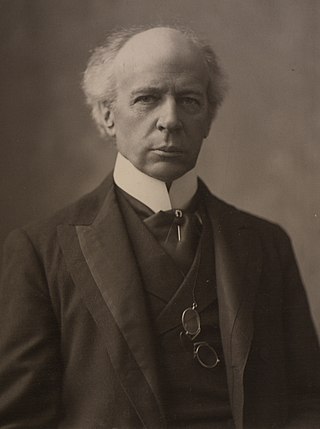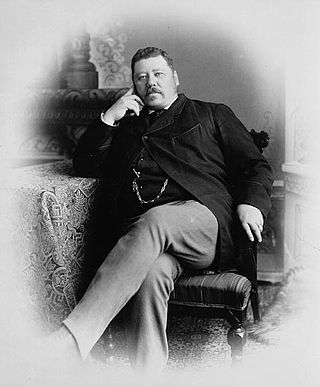
Alexander Mackenzie was a Canadian politician who served as the second prime minister of Canada, in office from 1873 to 1878.

Sir Charles Tupper, 1st Baronet,, M.D. was a Canadian Father of Confederation who served as the sixth prime minister of Canada from May 1 to July 8, 1896. As the premier of Nova Scotia from 1864 to 1867, he led Nova Scotia into Confederation. He briefly served as the Canadian prime minister, from seven days after parliament had been dissolved, until he resigned on July 8, 1896, following his party's loss in the 1896 Canadian federal election. He is the only medical doctor to have ever held the office of prime minister of Canada and his 68-day tenure as prime minister is the shortest in Canadian history.

Sir John Alexander Macdonald was the first prime minister of Canada, serving from 1867 to 1873 and from 1878 to 1891. He was the dominant figure of Canadian Confederation, and had a political career that spanned almost half a century.

Sir Henri Charles Wilfrid Laurier, was a Canadian lawyer, statesman, and politician who served as the seventh prime minister of Canada from 1896 to 1911. The first French Canadian prime minister, his 15-year tenure remains the longest uninterrupted term of office among Canadian prime ministers and his nearly 45 years of service in the House of Commons is a record for the House. Laurier is best known for his compromises between English and French Canada.

Sir John Joseph Caldwell Abbott was a Canadian lawyer and politician who served as the third prime minister of Canada from 1891 to 1892. He held office as the leader of the Conservative Party.

The Conservative Party of Canada has gone by a variety of names over the years since Canadian Confederation. Initially known as the "Liberal-Conservative Party", it dropped "Liberal" from its name in 1873, although many of its candidates continued to use this name.
The National Policy was a Canadian economic program introduced by John A. Macdonald's Conservative Party in 1876. After Macdonald led the Conservatives to victory in the 1878 Canadian federal election, he began implementing his policy in 1879. The protective policy had shown positive responses in the economy with new industries flourishing Canada's economy in the 1880s. John A. Macdonald combined three elements as a strategy for the post-Confederation economy. First, by calling for high tariffs on imported manufactured items to protect the manufacturing industry. Second, by calling for a massive expansion of physical infrastructure, such as roads and railroads. Finally, enabled and supported by the former two, by promoting population growth, particularly in western Canada. The building of the Canadian Pacific Railway, and the fostering of immigration to Western Canada. Macdonald campaigned on the policy in the 1878 election, and defeated the Liberal Party, which supported free trade. It lasted from 1879 until sometime in the early 1950s.

The Crédit Mobilier scandal was a two-part fraud conducted from 1864 to 1867 by the Union Pacific Railroad and the Crédit Mobilier of America construction company in the building of the eastern portion of the first transcontinental railroad. The story was broken by The New York Sun during the 1872 campaign of Ulysses S. Grant.

The 1872 Canadian federal election was held from July 20 to October 12, 1872, to elect members of the House of Commons of Canada of the 2nd Parliament of Canada. Prime Minister Sir John A. Macdonald's Conservative Party remained in power, defeating the Liberals. However, the Liberals increased their parliamentary representation considerably, while the Conservative seat count remained static, giving them only six more seats than the Liberals. The election produced the country's first minority government. The support of two independent Conservative MPs functionally gave Macdonald an extremely slim majority that allowed it to survive for two years, until it fell due to scandal.

John Norquay was the fifth premier of Manitoba from 1878 to 1887. He was born near St. Andrews in what was then the Red River Colony, making him the first Premier of Manitoba to have been born in the region. Norquay was also the first Indigenous Premier of a Canadian province, a title which is now honourarily held by Louis Riel.

Peter Mitchell was a Canadian politician and one of the Fathers of Confederation.

The 1874 Canadian federal election was held on January 22, 1874, to elect members of the House of Commons of Canada of the 3rd Parliament of Canada. Sir John A. Macdonald, who had recently been forced out of office as prime minister, and his Conservatives were defeated by the Liberal Party under their new leader Prime Minister Alexander Mackenzie.

Joseph-Édouard Cauchon, was a prominent Quebec politician in the middle years of the nineteenth-century. Although he held a variety of portfolios at the federal, provincial and municipal levels, he never achieved his goal of becoming the Premier of Quebec.

The 1878 Canadian federal election was held on September 17, 1878, to elect members of the House of Commons of the 4th Parliament of Canada. It resulted in the end of Prime Minister Alexander Mackenzie's Liberal government after only one term in office. Canada suffered an economic depression during Mackenzie's term, and his party was punished by voters for it. The Liberals' policy of free trade also hurt their support with the business establishment in Toronto and Montreal.

The 2nd Canadian Parliament was in session from March 5, 1873, until January 2, 1874. The membership was set by the 1872 federal election from July 20 to October 12, 1872, and it changed only somewhat due to resignations and by-elections until it was dissolved prior to the 1874 election. Among the by-elections were the first election of PEI MPs, PEI joining Confederation in 1873.

Lucius Seth Huntington, was a Canadian lawyer, journalist and political figure. He was a Liberal member of the House of Commons of Canada representing Shefford from 1867 to 1882. He also served as President of the Queen's Privy Council for Canada and Postmaster General.

Charles Dewey Day, was a lawyer, judge and political figure in Lower Canada and Canada East. He was a member of the Special Council of Lower Canada, which governed Lower Canada after the Lower Canada Rebellions in 1837 and 1838. He was elected to the first Legislative Assembly of the Province of Canada in 1841, but resigned in 1842 to accept an appointment to the Court of Queen's Bench of Lower Canada.

Post-Confederation Canada (1867–1914) is history of Canada from the formation of the Dominion to the outbreak of World War I in 1914. Canada had a population of 3.5 million, residing in the large expanse from Cape Breton to just beyond the Great Lakes, usually within a hundred miles or so of the Canada–United States border. One in three Canadians was French, and about 100,000 were aboriginal. It was a rural country composed of small farms. With a population of 115,000, Montreal was the largest city, followed by Toronto and Quebec at about 60,000. Pigs roamed the muddy streets of Ottawa, the small new national capital.

This article is the Electoral history of Sir John A. Macdonald, the first prime minister of Canada.

The Oaths Act, 1873, was a statute passed by the Parliament of Canada in 1873 which authorized any committee of the Senate or House of Commons to examine witnesses under oath.


















